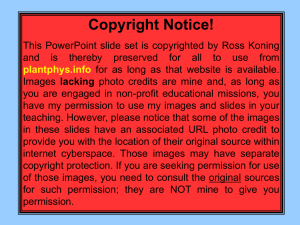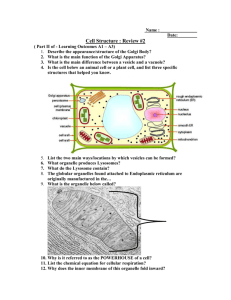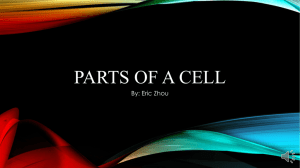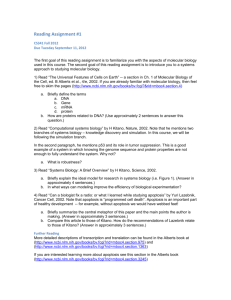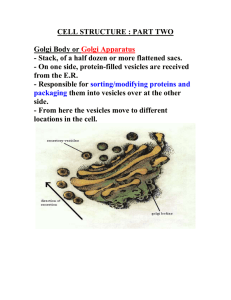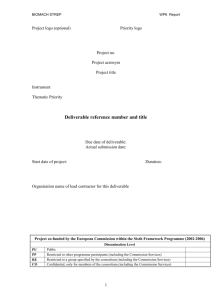Microtubules: Dynamic Stability
advertisement
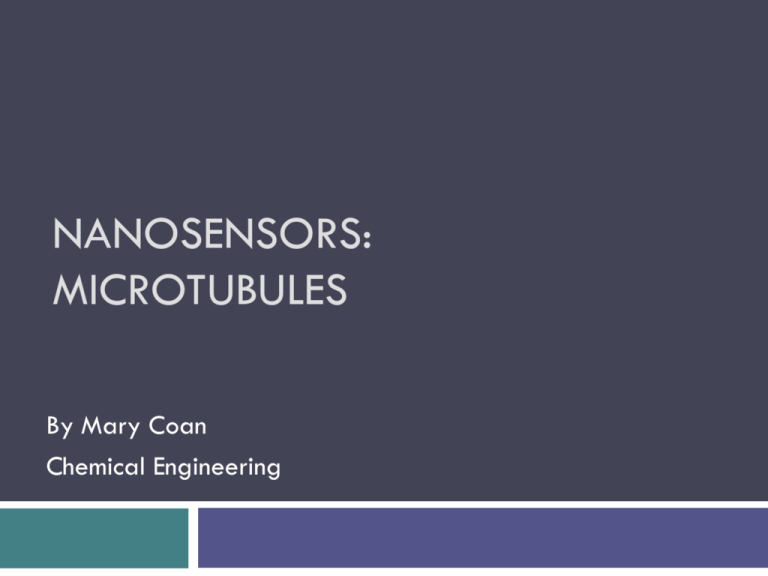
NANOSENSORS: MICROTUBULES By Mary Coan Chemical Engineering Outline Nanosensors Introduction to Microtubules (MT’s) Formation of MT’s Dynamic Instability of MT’s Applications of MT’s Bio-Nanosensor Transporter Assessment of Performed Work Nanosensors Detect very small particles or quantity of something Chemical, Mechanical or Biological sensors Amongst other applications they can be used: To detect various chemicals in gases for pollution monitoring For medical diagnostic purposes either as blood borne sensors or in lab-on-a-chip type devices To monitor physical parameters such as temperature, displacement and flow As accelerometers in MEMS devices like airbag sensors http://www.azonano.com/details.asp?ArticleID=1840 1) http://thewere42.files.wordpress.com/2009/11/500x_iphonetricorder.jpg 2) http://www.medgadget.com/archives/img/nanosensor.jpg 3) http://www.bu.edu/eng/newscms/photos/soundlight thumbnail2.jpg 4) http://www.ck12.org/ck12/images?id=127659 Nanosensors Bio-nanosensors Single molecule or molecular complex based Proteins, antibodies, enzymes, DNA, and RNA Cell-based Whole cells, tissue or whole organisms Problems with bio-nanosensors Human interaction causes errors Low signals (dim fluorescence) http://www.rpi.edu/dept/chem-eng/Biotech-Environ/BIOSEN/biosen.htm, Thorsten Fischer, et.al. “A smart dust biosensor powered by kinesin motors” Nature Nanotech Letters, 2009 Outline Nanosensors Introduction to Microtubules (MT’s) Formation of MT’s Dynamic Instability of MT’s Applications of MT’s Bio-Nanosensor Transporter Assessment of Performed Work Introduction to Microtubules (MT’s) A principal component of the cytoskeleton (cellular scaffolding/skeleton made out of protein, present in all cells) Rigid hollow rods approximately 25 nm in diameter Single type of globular protein called tubulin http://www.ncbi.nlm.nih.gov/bookshelf/br.fcgi?book=cooper&part=A1820 , http://www.ncbi.nlm.nih.gov/bookshelf/br.fcgi?book=mcb&part=A5406 Introduction to Microtubules (MT’s) Tubulin Polymerize to form MT’s Dimers made up of 2 closely related polypeptides called αβ-tubulin Polar structures, fast-growing plus end and slowgrowing minus end Bind to GTP (Guanasine triphosphate), source of energy for protein synthesis α β GTP functions analogously to the ATP (adenosine triphosphate) bound to actin to regulate polymerization Υ-tubulin localized to the centrosome (main MT organizing center (MTOC) of the animal cell as well as a regulator of the cell-cycle progression) Initiates MT assembly http://www.ncbi.nlm.nih.gov/bookshelf/br.fcgi?book=cooper&part=A1820 , http://www.ncbi.nlm.nih.gov/bookshelf/br.fcgi?book=mcb&part=A5406 Introduction to Microtubules (MT’s) http://www.ncbi.nlm.nih.gov/bookshelf/br.fcgi?book=cooper&part=A1820 , http://www.ncbi.nlm.nih.gov/bookshelf/br.fcgi?book=mcb&part=A5406 Introduction to Microtubules (MT’s) Are dynamic structures that undergo continual assembly and disassembly within the cell Function both to determine cell shape and in a variety of cell movements cell locomotion, the intracellular transport of organelles, and the separation of chromosomes during mitosis http://www.ncbi.nlm.nih.gov/bookshelf/br.fcgi?book=cooper&part=A1820 , http://www.ncbi.nlm.nih.gov/bookshelf/br.fcgi?book=mcb&part=A5406 Outline Nanosensors Introduction to Microtubules (MT’s) Formation of MT’s Dynamic Instability of MT’s Applications of MT’s Bio-Nanosensor Transporter Assessment of Performed Work Formation of Microtubules (MT’s) Complexes of γ-tubulin form ring structures that contain 10 to 13 γ-tubulin molecules and have diameters similar to those of MT’s γ-tubulin rings nucleation May sites for the assembly of microtubules remain bound to their minus ends MT’s extend outward from the MT organizing center (MTOC) http://www.ncbi.nlm.nih.gov/bookshelf/br.fcgi?book=cooper&part=A1820 , http://www.ncbi.nlm.nih.gov/bookshelf/br.fcgi?book=mcb&part=A5406 Formation of Microtubules (MT’s) α β α β α β Outline Nanosensors Introduction to Microtubules (MT’s) Formation of MT’s Dynamic Instability of MT’s Applications of MT’s Bio-Nanosensor Transporter Assessment of Performed Work Dynamic Instability of MT’s Each αβ-tubulin is bound to a GTP molecule GTP is hydrolyzed to GDP when the tubulin dimers are added to the plus end of the growing microtubule GTP hydrolysis is not mandatory for microtubule formation only GDP-bound tubulin molecules are able to depolymerize GTP-bound tubulin serve as a cap at the tip of microtubule to protect from depolymerization http://www.ncbi.nlm.nih.gov/bookshelf/br.fcgi?book=cooper&part=A1820 , http://www.ncbi.nlm.nih.gov/bookshelf/br.fcgi?book=mcb&part=A5406 Dynamic Instability of MT’s GTP bound tubulin are hydrolyzed to GDP during or shortly after polymerization weakens the binding affinity of tubulin for adjacent molecules favors depolymerization resulting in the dynamic behavior of microtubules GTP hydrolysis results in the behavior known as dynamic instability Alternate between cycles of growth and shrinkage Determined by the rate of tubulin addition relative to the rate of GTP hydrolysis http://www.ncbi.nlm.nih.gov/bookshelf/br.fcgi?book=cooper&part=A1820 , http://www.ncbi.nlm.nih.gov/bookshelf/br.fcgi?book=mcb&part=A5406 Dynamic Instability of MT’s If new GTP-bound tubulin molecules are added more rapidly than GTP is hydrolyzed microtubule retains a GTP cap at its plus end and microtubule growth continues Rate of polymerization slows, the GTP bound to tubulin at the plus end of the microtubule will be hydrolyzed to GDP GDP-bound tubulin will dissociate Results in rapid depolymerization and shrinkage of the microtubule. Dynamic instability results in the continual and rapid turnover of most MT’s http://www.ncbi.nlm.nih.gov/bookshelf/br.fcgi?book=cooper&part=A1820 , http://www.ncbi.nlm.nih.gov/bookshelf/br.fcgi?book=mcb&part=A5406 Dynamic Instability of MT’s MT’s can be stabilized Chemotherapy Taxane Drug Class, e.g. Docetaxel Stabilizes GDP bound tubulin in the MT’s Hydrolysis of the GTP cap does not result in depolymerization http://www.ncbi.nlm.nih.gov/bookshelf/br.fcgi?book=cooper&part=A1820 , http://www.ncbi.nlm.nih.gov/bookshelf/br.fcgi?book=mcb&part=A5406 Outline Nanosensors Introduction to Microtubules (MT’s) Formation of MT’s Dynamic Instability of MT’s Applications of MT’s Bio-Nanosensor Transporter Assessment of Performed Work Application of MT’s Typical target applications of MT’s Drugs that affect microtubule assembly are useful not only as experimental tools in cell biology but also in the treatment of cancer Some experimental drugs bind tubulin and inhibit microtubule polymerization, thus stops mitosis Selectively inhibit rapidly dividing cells Stabilizes microtubules rather than inhibiting their assembly, blocks cell division Newer application Transporters for bio-nanosensors http://www.ncbi.nlm.nih.gov/bookshelf/br.fcgi?book=cooper&part=A1820 , http://www.ncbi.nlm.nih.gov/bookshelf/br.fcgi?book=mcb&part=A5406 Thorsten Fischer, et.al. “A smart dust biosensor powered by kinesin motors” Nature Nanotech Letters, 2009 Bio-Nanosensor Transporter Traditional double-antibody-sandwich (DAS) assays Dr. Fischer replaced the wash step with a transport step powered by adenosine triphosphate (ATP) Thorsten Fischer, et.al. “A smart dust biosensor powered by kinesin motors” Nature Nanotech Letters, 2009 Bio-Nanosensor Transporter Thorsten Fischer, et.al. “A smart dust biosensor powered by kinesin motors” Nature Nanotech Letters, 2009 Bio-Nanosensor Transporter Thorsten Fischer, et.al. “A smart dust biosensor powered by kinesin motors” Nature Nanotech Letters, 2009 Positive End Minus End α ADP Kinesin ATP P α β PP β PP Bio-Nanosensor Transporter Dr. Fischer tested the new device Two different unlabeled analytes were tested using different tags Fluorescent Nanospheres functionalized to attach to the analyte Quantum Nanodots conjugated to an antibody New device accounts for the time required for the Analyte/tag to diffuse to the functionalized MT MT to move to the boundary of the cell Thorsten Fischer, et.al. “A smart dust biosensor powered by kinesin motors” Nature Nanotech Letters, 2009 Bio-Nanosensor Transporter Speed of the MT’s was modified by controlling the ATP concentration depending on which analyte was to be captured Based on diffusion rates Concentrations of the analyte, tags and antibodies functionalized to the MT’s were varied Increased signal (brighter flouresence) Thorsten Fischer, et.al. “A smart dust biosensor powered by kinesin motors” Nature Nanotech Letters, 2009 Bio-Nanosensor Transporter Six hours after analyte introduction, microtubules have aggregated at the wall, depositing along with them a ring of nanospheres MT’s Nanospheres Thorsten Fischer, et.al. “A smart dust biosensor powered by kinesin motors” Nature Nanotech Letters, 2009 Bio-Nanosensor Transporter Imaging the peripheral region at higher magnification 3 h after the start of the experiment reveals microtubule and nanosphere accumulation at the wall Nanospheres MT’s Thorsten Fischer, et.al. “A smart dust biosensor powered by kinesin motors” Nature Nanotech Letters, 2009 Bio-Nanosensor Transporter After experimentation Dr. Fischer decided that the distinction between the zones for analyte pick-up and tagging should be abolished: First, it is acceptable for the analyte to bind to the antibody on the tag first and then to the antibody on the gliding shuttle Second, a sufficient number of encounters between shuttles and tags still occurs Third, the device assembly process is dramatically simplified Thorsten Fischer, et.al. “A smart dust biosensor powered by kinesin motors” Nature Nanotech Letters, 2009 Outline Nanosensors Introduction to Microtubules (MT’s) Formation of MT’s Dynamic Instability of MT’s Applications of MT’s Bio-Nanosensor Transporter Assessment of Performed Work Assessment of Performed Work Very innovative First biologically motorized detecting device Failure to mention on the MT’s were stabilized Potential effects from non-stabilized MT’s Future work Different analytes need to be tested Strategies to manufacture, package and store Performance needs to be optimized and matched to specific applications Signal strength needs to be improved for remote detection Questions ? G3 Rebuttal: Nanosensors Microtubules Mary Coan Rebuttal • “An additional interesting point not discussed during the presentation is how can we exploit the ‘dynamic’ self-assembling properties intrinsic to microtubules for nanosensing and nano-engineering.” – This was not discussed due to time. However it was briefly mentioned that research into the topic was done but many of the papers found only discussed the targeting the MT’s instead of using the MT’s as nanosensors. For an example, a lot of research has been conducted to inhibit the dynamic instability of MT’s. • “Nonetheless, it was perhaps too much material for a short time” and “There was a lot of material covered in the slides, perhaps to fast to comprehend in the amount of time given. It became hard to follow at some points.” – You are correct, there was a lot of information presented in a short time. I wanted the audience to understand the dynamic instability of MT’s, which is one of the most important details about MT’s. Without MT’s mitosis would not occur. I also wanted the audience to fully understand how the MT’s transported nanosensors, which is the first nanotransporter using only biological materials. – I did limit some of the information presented. This may have caused the audience to become confused or lost at certain points in the presentation. Rebuttal • “I could see that the time frames relevant to the technique are quite large, which would create inconveniences for real time measurements and monitoring and quick action expected from point-of-care approaches.” – You are correct. However, I did mention that the authors proposed removing the separate regions, ie capture and tag regions, to decrease the amount of time needed to detect the analyte. Another point to mention is that the same amount of time, if not more, is required to perform the traditional double-antibodysandwich (DAS) assays. • “The graphics and text were well balanced, and the graphics aided a great deal in trying to understand the content of the presentation.” – Thank you. I try to include motion into my presentation to help the audience. Rebuttal • “The speaker covered all relevant topics from an introduction of the research to how it can be furthered. It might have been nice to have heard some of the opposition to such research and or more research in the same field, but overall the presentation was well balanced and informative.” – Thank you, I was struggling to keep the information too excessive and thus did not include more research in the same field or others points of view G1 Review Nanosensing, Microtubules by Edson Bellido The presenter described what are bio-nanosensors and microtubules. She described how the microtubules are formed within the cell. She explained what is the dynamic instability and what molecules affect this behavior of the microtubules. She explained how the microtubules are being used as bionanosensor transporter. She explained how the kinase moves the microtubule to the cell boundaries and allow us to detect analytes captured within the cell. Something missing was the details about the experimental procedures, most likely because of the short time for the presentation. those details are very important factor to analyze and determine the accuracy and reproducibility of the system. Other factor to study will be how the addition of those functionalized MTs and the quantum dots will affect the cellular response. If it affects; quantitatively how this response change the accuracy of the measure?. http://www.cancerquest.org/images/microtubules.gif G2 Review Nanosensing, Microtubules by Alfredo Bobadilla Review of Nanosensing & Microtubules • Microtubules are biological nanostructures. They are part of the cytoskeleton which actually look like the nervous system of the biological cell and they indeed transmit vibrational signals, perform mechanotransduction, own a highly dynamic behavior because of self-assembly dynamic process (dynamic instability) and have been found to be involved in cell decision-process mechanisms as well as in memory & learning functions. • It was shown in the lecture how functionalized microtubules can be used for nanosensing purposes and as a nanotransporter. • An additional interesting point not discussed during the presentation is how can we exploit the ‘dynamic’ self-assembling properties intrinsic to microtubules for nanosensing and nano-engineering. Alfredo D. Bobadilla G4 Microtubules Summary and review Diego A Gomez-Gualdrón Microtubules •Microtubules (MT) are part of the cytoskeleton and posses a diameter of ~ 25 nm, and a length of ~ 250 nm •Microtubules (MT) can transmit signals as well as transport substances within the cells •They are formed by a ‘polymerization mechanism’ Functionalizing a microtubule can make it suitable as a fully-biologically-constitued nanosensor Sensing Mechanism • It was shown that functionalizing a MT with an antibody allows for specific binding of the analyte. • The interaction of kinesin with the MT enables the transport of the analyte to tagging and detection stages MT Detection occurs through fluorescence Comments • The presentation used a lot of didactic elements to convey the information and it was general a very good presentation. Nonetheless, it was perhaps too much material for a short time • I could see that the time frames relevant to the technique are quite large, which would create inconveniences for real time measurements and monitoring and quick action expected from pointof-care approaches. G5 Review Nanosensing, Microtubules by Norma Rangel Nanosensors: Microtubules By Mary Coan • Mary presented the use of microtubules as nanosensors, basic concepts, production of MTs, stability and alternative applications were shown. Also • Mary used great animations that helped for a better understanding of the Bio-Nanosensor Transporter concept. • I particularly like the criticism given to the paper, where she mentioned some missing details in the paper about the stability of the MTs and of course the toxicity of the MTs, but also including potential future work to further develop portable, cheap and more sensitive and stronger sensors. G6 Review Nanosensing, Microtubules by Jung Hwan Woo Questions • What is the mechanism to the selective inhibition of the rapid dividing cells? • Is there a way for the MT’s to differentiate a cancer cell from a normal cell that is rapidly dividing, for example, cells on a wounded skin? • Has there been animal tests on the effectiveness of the MT’s on cancer cells? • What was the method used to determine that the MT’s selectively inhibited rapidly dividing cells? Jung Hwan Woo U6 Review Nanosensing, Microtubules by Group U6 By Mary Coan Chemical Engineering Reviewed by: Group U6 - Pavitra Timbalia, Michael Trevathan, Jared Walker The speaker maintained a appropriate tone which was easily understandable. She maintained eye contact with the audience and didn’t not read off the slides. She seemed confident and knowledgeable of the subject of the presentation. There was a lot of material covered in the slides, perhaps to fast to comprehend in the amount of time given. It became hard to follow at some points. The graphics and text were well balanced, and the graphics aided a great deal in trying to understand the content of the presentation. The speaker covered all relevant topics from an introduction of the research to how it can be furthered. It might have been nice to have heard some of the opposition to such research and or more research in the same field, but overall the presentation was well balanced and informative.
